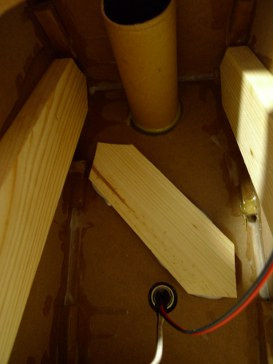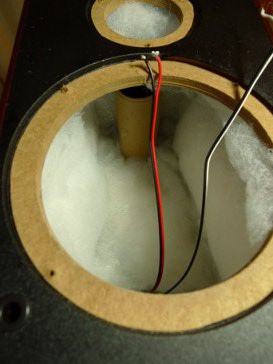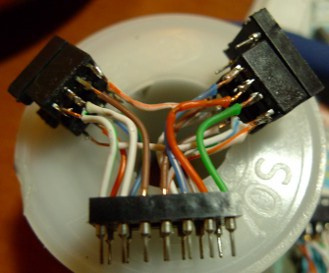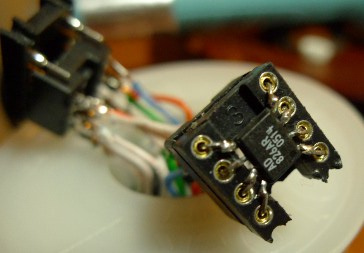Improving the sound of speakers Sven Stream
Good day, Habr!
At some point, I decided to upgrade my desktop speakers. The successor of the plywood-plastic gray boxes should be of sufficient quality (for the sake of this, the upgrade is started), but cheap (I listen to music mainly as a background while working). In addition, they should normally fit on the table. According to the results of Google, reading forums and reviews were selected Sven Stream. By virtue of the cheapness requirement, it was obvious that in the columns they would save on everything possible. From this followed the idea that even small and cheap improvements can significantly improve the sound. Well, besides it was interesting to play around picking the amplifier.
That's what came of it ...
')
The sound of the speakers is not particularly impressive, if not worse. Of course, they significantly overplayed their plastic-plywood predecessors, but only with a more pronounced tyts-boom and boom-boom. The sound was unintelligible, the mid frequencies were severely overwhelmed (practically absent). In general, the standard fake Chinese speakers - play, but not happy.
Column design: 3cm squeaker + 12.5 cm speaker. The body is made of MDF. In general, the box is pretty well assembled. The amplifier is assembled according to the bi-amping fashion scheme. LF and HF amplified separately from each other. Physically, it consists of two boards - (power amplifier + power supply) and (timbre). The power amplifier is assembled on two TDA7265, timbre on NE5532 and two TL084. Overview of speakers with measurements of the frequency response is on the trunk . Of page - here .
Requirements for possible improvements were quite simple - low cost and simplicity. Cheapness - because it makes no sense to improve cheap speakers at a high price, it is easier to immediately buy expensive ones, but this is not part of the initial plans. Simplicity - this restriction is dictated by the banal lack of the "circuitry" skill.
Googling of the Internet revealed the following improvements:
1) Sample extra. capacitors: shunting power amps + dopike in the PSU.
2) "Warming" columns.
3) Replacement of operational amplifiers with better ones.
4) Replacing power amplifiers with better ones. The very first attempt showed that, by virtue of the construction of the columns, it turns out to be quite a collective farm and I returned everything back.
5) Adding stabilizer to the power supply. I honestly failed this business. Collect sensible stabilizer did not work, but from the fact that it turned out was a good sense, but not enough. In the end, everything remained unchanged.
Along the way, besides the free sound improvement, it became interesting to conduct something like a micro-research on the subject of “the influenceof oxygen-free silver wires on components cast at midnight on the sound of speakers”, i.e. how and how much the replacement of each element affects the audible result.
All the work took about 4-5 nights, if you gather, you can collect everything in one day.
1) Sample extra. capacitors: shunting power amps + dopike in the PSU.
Cheap - 50p on capacitors. Simply - according to the datasheets (can be found here ), the amplifiers determine the legs to which the power is supplied and these legs are connected to ground through 0.1 μF capacitors. In addition, parallel to each capacitor in the power supply (these are the two healthiest in the entire assembly), observing the polarity is soldered two more so that the total capacity of the soldered + native is 10,000 microfarad. In total, I soldered 9 capacitors.
The result is very good, for the money spent is simply amazing. Tyts-tyts and boom-boom became very similar to the treble and woofer. The abyss in the MF has decreased to just fail. What is interesting is that the shunting of the power supply of the power amplifiers gave a greater effect than the shunting of the opamp in the timbre block. In general, it became much better to sound, although it’s not a good start yet.


2) "Warming" columns.
Cheap - ~ 90r. 40p for a wooden lath and about 50p for a synthetic winterizer. Simply - pieces of the slats are cut off and glued onto the walls of the columns. After drying, the wall glue is glued to the walls, except for the locations of the amplifiers.
The meaning of the action is to suppress possible vibrations and resonances of the speaker cabinet, thus removing the overtones and corps. Alternatively, insert spacers. The same effect is achieved, but glued MDF can simply crack / peel off, if not immediately then soon.
The result - in general there. Shells began to sound duller, if you knock on them, the sound seemed to be a little cleaner and a little quieter (although it may just not be so loud). Those. There is an effect, but far from being as drastic as from capacitors.


3) Replacing OU for better.
Not so cheap - 5 microcircuits of ~ 200r each (and even more expensive, depending on the model, oh) + panels for them 11p for better or 5p for worse.
More difficult than all the previous ones - first you need to drop out your own opamp, preferably not having burned them. In addition, quad columns are used in the columns, which complicates the replacement because all of them with good reviews are dual and therefore need an adapter. In nearby stores, it was possible to extract only part of the op in the dip cases, the rest had to be bought in soic. Here you can order normal adapters, but waiting for the end of prazdikov was not a hunt and I zakolhozil a few pieces.


The result is just a song! :) The most qualitative change, if you make any one tweak, then definitely this one. Although the review on the trunk and tells about 0.003% distortion - play native opamp simply sucks. To replace the native TL084 and NE5532, OPA2134 and AD826 were purchased, and as it turned out, any of them outplayed the native ones with two heads. OPA was supposed to replace the NE, and AD instead of TL. NE stood in the volume control and more than TL influenced the sound quality, although the replacement of the TL also significantly improved the sound. In practice, it turned out that the OPA in the volume control, compared with AD, has less bass and more treble (although they are worse). The sound of AD in general, I liked it more. Thus, OPA migrated to the high frequency part of one of the channels, and the volume and everything else works on AD. The difference in sound is almost not noticeable.
What could not win because it is 50Hz background. It is necessary, apparently, to dig deeper.
The result: after the work done, the sound of the speakers began to naturally rejoice. It became interesting to listen to the classics - it finally became audible :) The costs were about 1/3 of the cost of the speakers, which in my opinion is quite acceptable. In addition, the understanding of what is happening in the speakers / amplifiers has significantly increased, and the expansion of horizons always delivers :)
At some point, I decided to upgrade my desktop speakers. The successor of the plywood-plastic gray boxes should be of sufficient quality (for the sake of this, the upgrade is started), but cheap (I listen to music mainly as a background while working). In addition, they should normally fit on the table. According to the results of Google, reading forums and reviews were selected Sven Stream. By virtue of the cheapness requirement, it was obvious that in the columns they would save on everything possible. From this followed the idea that even small and cheap improvements can significantly improve the sound. Well, besides it was interesting to play around picking the amplifier.
That's what came of it ...
')
The sound of the speakers is not particularly impressive, if not worse. Of course, they significantly overplayed their plastic-plywood predecessors, but only with a more pronounced tyts-boom and boom-boom. The sound was unintelligible, the mid frequencies were severely overwhelmed (practically absent). In general, the standard fake Chinese speakers - play, but not happy.
Column design: 3cm squeaker + 12.5 cm speaker. The body is made of MDF. In general, the box is pretty well assembled. The amplifier is assembled according to the bi-amping fashion scheme. LF and HF amplified separately from each other. Physically, it consists of two boards - (power amplifier + power supply) and (timbre). The power amplifier is assembled on two TDA7265, timbre on NE5532 and two TL084. Overview of speakers with measurements of the frequency response is on the trunk . Of page - here .
Requirements for possible improvements were quite simple - low cost and simplicity. Cheapness - because it makes no sense to improve cheap speakers at a high price, it is easier to immediately buy expensive ones, but this is not part of the initial plans. Simplicity - this restriction is dictated by the banal lack of the "circuitry" skill.
Googling of the Internet revealed the following improvements:
1) Sample extra. capacitors: shunting power amps + dopike in the PSU.
2) "Warming" columns.
3) Replacement of operational amplifiers with better ones.
4) Replacing power amplifiers with better ones. The very first attempt showed that, by virtue of the construction of the columns, it turns out to be quite a collective farm and I returned everything back.
5) Adding stabilizer to the power supply. I honestly failed this business. Collect sensible stabilizer did not work, but from the fact that it turned out was a good sense, but not enough. In the end, everything remained unchanged.
Along the way, besides the free sound improvement, it became interesting to conduct something like a micro-research on the subject of “the influence
All the work took about 4-5 nights, if you gather, you can collect everything in one day.
1) Sample extra. capacitors: shunting power amps + dopike in the PSU.
Cheap - 50p on capacitors. Simply - according to the datasheets (can be found here ), the amplifiers determine the legs to which the power is supplied and these legs are connected to ground through 0.1 μF capacitors. In addition, parallel to each capacitor in the power supply (these are the two healthiest in the entire assembly), observing the polarity is soldered two more so that the total capacity of the soldered + native is 10,000 microfarad. In total, I soldered 9 capacitors.
The result is very good, for the money spent is simply amazing. Tyts-tyts and boom-boom became very similar to the treble and woofer. The abyss in the MF has decreased to just fail. What is interesting is that the shunting of the power supply of the power amplifiers gave a greater effect than the shunting of the opamp in the timbre block. In general, it became much better to sound, although it’s not a good start yet.


2) "Warming" columns.
Cheap - ~ 90r. 40p for a wooden lath and about 50p for a synthetic winterizer. Simply - pieces of the slats are cut off and glued onto the walls of the columns. After drying, the wall glue is glued to the walls, except for the locations of the amplifiers.
The meaning of the action is to suppress possible vibrations and resonances of the speaker cabinet, thus removing the overtones and corps. Alternatively, insert spacers. The same effect is achieved, but glued MDF can simply crack / peel off, if not immediately then soon.
The result - in general there. Shells began to sound duller, if you knock on them, the sound seemed to be a little cleaner and a little quieter (although it may just not be so loud). Those. There is an effect, but far from being as drastic as from capacitors.


3) Replacing OU for better.
Not so cheap - 5 microcircuits of ~ 200r each (and even more expensive, depending on the model, oh) + panels for them 11p for better or 5p for worse.
More difficult than all the previous ones - first you need to drop out your own opamp, preferably not having burned them. In addition, quad columns are used in the columns, which complicates the replacement because all of them with good reviews are dual and therefore need an adapter. In nearby stores, it was possible to extract only part of the op in the dip cases, the rest had to be bought in soic. Here you can order normal adapters, but waiting for the end of prazdikov was not a hunt and I zakolhozil a few pieces.


The result is just a song! :) The most qualitative change, if you make any one tweak, then definitely this one. Although the review on the trunk and tells about 0.003% distortion - play native opamp simply sucks. To replace the native TL084 and NE5532, OPA2134 and AD826 were purchased, and as it turned out, any of them outplayed the native ones with two heads. OPA was supposed to replace the NE, and AD instead of TL. NE stood in the volume control and more than TL influenced the sound quality, although the replacement of the TL also significantly improved the sound. In practice, it turned out that the OPA in the volume control, compared with AD, has less bass and more treble (although they are worse). The sound of AD in general, I liked it more. Thus, OPA migrated to the high frequency part of one of the channels, and the volume and everything else works on AD. The difference in sound is almost not noticeable.
What could not win because it is 50Hz background. It is necessary, apparently, to dig deeper.
The result: after the work done, the sound of the speakers began to naturally rejoice. It became interesting to listen to the classics - it finally became audible :) The costs were about 1/3 of the cost of the speakers, which in my opinion is quite acceptable. In addition, the understanding of what is happening in the speakers / amplifiers has significantly increased, and the expansion of horizons always delivers :)
Source: https://habr.com/ru/post/111119/
All Articles